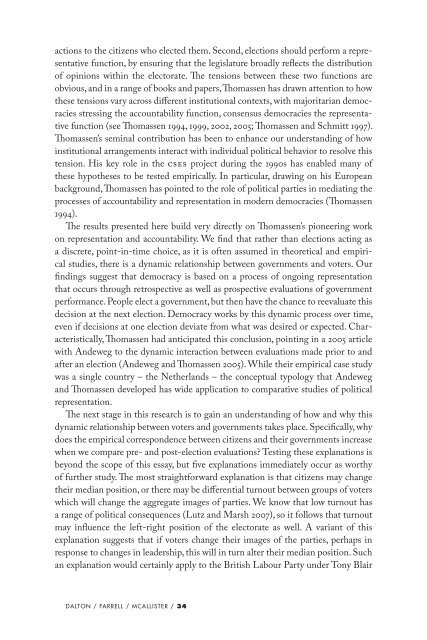download - UvA DARE
download - UvA DARE
download - UvA DARE
You also want an ePaper? Increase the reach of your titles
YUMPU automatically turns print PDFs into web optimized ePapers that Google loves.
actions to the citizens who elected them. Second, elections should perform a representative<br />
function, by ensuring that the legislature broadly reflects the distribution<br />
of opinions within the electorate. The tensions between these two functions are<br />
obvious, and in a range of books and papers, Thomassen has drawn attention to how<br />
these tensions vary across different institutional contexts, with majoritarian democracies<br />
stressing the accountability function, consensus democracies the representative<br />
function (see Thomassen 1994, 1999, 2002, 2005; Thomassen and Schmitt 1997).<br />
Thomassen’s seminal contribution has been to enhance our understanding of how<br />
institutional arrangements interact with individual political behavior to resolve this<br />
tension. His key role in the CSES project during the 1990s has enabled many of<br />
these hypotheses to be tested empirically. In particular, drawing on his European<br />
background, Thomassen has pointed to the role of political parties in mediating the<br />
processes of accountability and representation in modern democracies (Thomassen<br />
1994).<br />
The results presented here build very directly on Thomassen’s pioneering work<br />
on representation and accountability. We find that rather than elections acting as<br />
a discrete, point-in-time choice, as it is often assumed in theoretical and empirical<br />
studies, there is a dynamic relationship between governments and voters. Our<br />
findings suggest that democracy is based on a process of ongoing representation<br />
that occurs through retrospective as well as prospective evaluations of government<br />
performance. People elect a government, but then have the chance to reevaluate this<br />
decision at the next election. Democracy works by this dynamic process over time,<br />
even if decisions at one election deviate from what was desired or expected. Characteristically,<br />
Thomassen had anticipated this conclusion, pointing in a 2005 article<br />
with Andeweg to the dynamic interaction between evaluations made prior to and<br />
after an election (Andeweg and Thomassen 2005). While their empirical case study<br />
was a single country – the Netherlands – the conceptual typology that Andeweg<br />
and Thomassen developed has wide application to comparative studies of political<br />
representation.<br />
The next stage in this research is to gain an understanding of how and why this<br />
dynamic relationship between voters and governments takes place. Specifically, why<br />
does the empirical correspondence between citizens and their governments increase<br />
when we compare pre- and post-election evaluations? Testing these explanations is<br />
beyond the scope of this essay, but five explanations immediately occur as worthy<br />
of further study. The most straightforward explanation is that citizens may change<br />
their median position, or there may be differential turnout between groups of voters<br />
which will change the aggregate images of parties. We know that low turnout has<br />
a range of political consequences (Lutz and Marsh 2007), so it follows that turnout<br />
may influence the left-right position of the electorate as well. A variant of this<br />
explanation suggests that if voters change their images of the parties, perhaps in<br />
response to changes in leadership, this will in turn alter their median position. Such<br />
an explanation would certainly apply to the British Labour Party under Tony Blair<br />
dAlton / fArrell / mcAllIster / 34
















